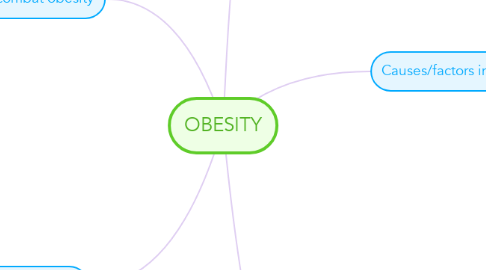
1. Steps to combat obesity
1.1. Eat less
1.1.1. Reduce caloric intake and count calories
1.2. Eat better
1.2.1. Eat vegetables, organic foods, natural foods, instead of fattening and sugary foods
1.3. Exercise more
1.3.1. Get at least 150 minutes (2 ½ hours) of moderately intense aerobic activity each week
1.4. Extreme cases: surgery
1.4.1. gastric bypass
1.4.2. bariatric surgery
1.5. Success stories
2. Effects of obesity
2.1. Physical/Health
2.1.1. Type 2 diabetes, heart disease, high blood pressure, stroke, kidney disease, and certain cancers are some of the diseases linked to excess weight
2.2. Emotional
2.2.1. Those with obesity may experience shame and emotional suffering
2.3. Economic
2.3.1. The estimated annual medical cost of obesity in the U.S. was $147 billion in 2008 U.S. dollars
3. What is obesity?
3.1. Definition
3.1.1. Body weight that’s greater than what is considered healthy for a certain height
3.2. How to calculate
3.2.1. Body mass index (BMI) is one way to tell whether you are at a normal weight, overweight, or obese. The BMI measures your weight in relation to your height
4. Causes/factors involved in obesity
4.1. Genetic predispositions/influences
4.2. Physical environment
4.2.1. Example: limited to driving instead of walking
4.2.2. Example: living in a place with no sidewalks
4.3. Socioeconomic stance
4.4. Life choices
4.4.1. Example: eating out instead of cooking at home
4.4.2. Example: fatty foods instead of organic
4.5. Culture
4.5.1. Some cultures have foods with a lot of fat or sugar, making it hard to manage weight
4.5.2. Family events at which people eat large amounts of food may make it tough to control portions
4.6. Sleep
4.6.1. Sleeping less may make it harder to lose weight
